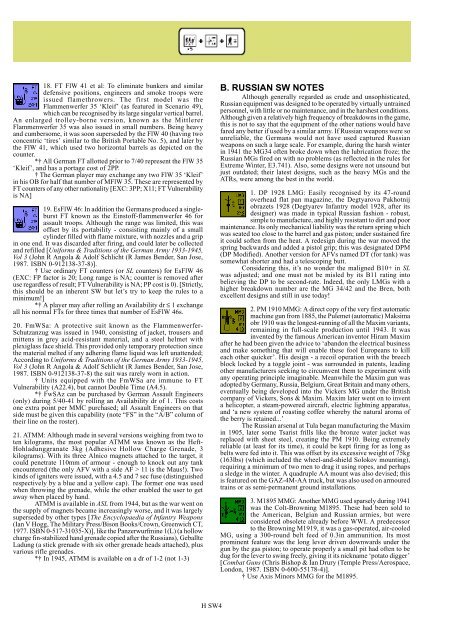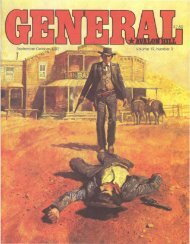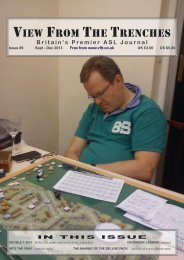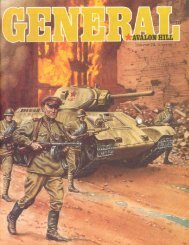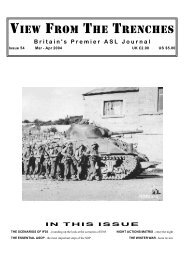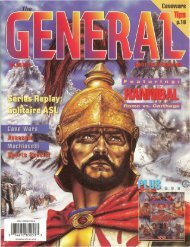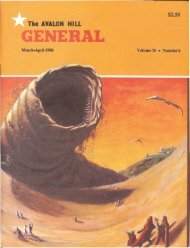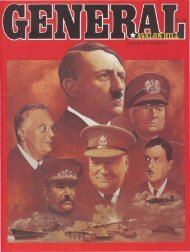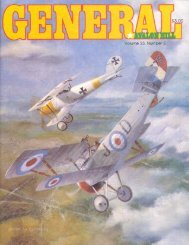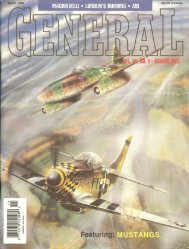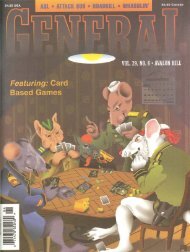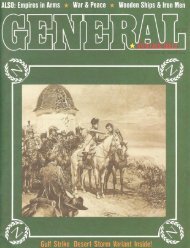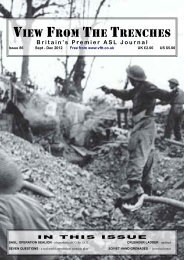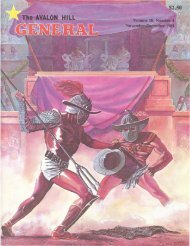VFTT28 - VFTT, Britain's Premier ASL Journal
VFTT28 - VFTT, Britain's Premier ASL Journal
VFTT28 - VFTT, Britain's Premier ASL Journal
You also want an ePaper? Increase the reach of your titles
YUMPU automatically turns print PDFs into web optimized ePapers that Google loves.
18. FT FlW 41 et al: To eliminate bunkers and similar<br />
defensive positions, engineers and smoke troops were<br />
issued flamethrowers. The first model was the<br />
Flammenwerfer 35 ‘Kleif’ (as featured in Scenario 49),<br />
which can be recognised by its large singular vertical barrel.<br />
An enlarged trolley-borne version, known as the Mittlerer<br />
Flammenwerfer 35 was also issued in small numbers. Being heavy<br />
and cumbersome, it was soon superseded by the FlW 40 (having two<br />
concentric ‘tires’ similar to the British Portable No. 5), and later by<br />
the FlW 41, which used two horizontal barrels as depicted on the<br />
counter. *† All German FT allotted prior to 7/40 represent the FlW 35<br />
‘Kleif’, and has a portage cost of 2PP.<br />
† The German player may exchange any two FlW 35 ‘Kleif’<br />
in his OB for half that number of MFlW 35. These are represented by<br />
FT counters of any other nationality [EXC: 3PP; X11; FT Vulnerability<br />
is NA]<br />
19. EsFlW 46: In addition the Germans produced a singleburst<br />
FT known as the Einstoff-flammenwerfer 46 for<br />
assault troops. Although the range was limited, this was<br />
offset by its portability - consisting mainly of a small<br />
cylinder filled with flame mixture, with nozzles and a grip<br />
in one end. It was discarded after firing, and could later be collected<br />
and refilled [Uniforms & Traditions of the German Army 1933-1945,<br />
Vol 3 (John R Angola & Adolf Schlicht (R James Bender, San Jose,<br />
1987. ISBN 0-912138-37-8)].<br />
† Use ordinary FT counters (or SL counters) for EsFlW 46<br />
(EXC: FP factor is 20; Long range is NA; counter is removed after<br />
use regardless of result; FT Vulnerability is NA; PP cost is 0). [Strictly,<br />
this should be an inherent SW but let’s try to keep the rules to a<br />
minimum!]<br />
*† A player may after rolling an Availability dr ≤ 1 exchange<br />
all his normal FTs for three times that number of EsFlW 46s.<br />
20. FmWSa: A protective suit known as the Flammenwerfer-<br />
Schutzanzug was issued in 1940, consisting of jacket, trousers and<br />
mittens in grey acid-resistant material, and a steel helmet with<br />
plexiglass face shield. This provided only temporary protection since<br />
the material melted if any adhering flame liquid was left unattended;<br />
According to Uniforms & Traditions of the German Army 1933-1945,<br />
Vol 3 (John R Angola & Adolf Schlicht (R James Bender, San Jose,<br />
1987. ISBN 0-912138-37-8) the suit was rarely worn in action.<br />
† Units equipped with the FmWSa are immune to FT<br />
Vulnerability (A22.4), but cannot Double Time (A4.5).<br />
*† FwSAz can be purchased by German Assault Engineers<br />
(only) during 5/40-41 by rolling an Availability dr of 1. This costs<br />
one extra point per MMC purchased; all Assault Engineers on that<br />
side must be given this capability (note “FS” in the “A/B” column of<br />
their line on the roster).<br />
21. ATMM: Although made in several versions weighing from two to<br />
ten kilograms, the most popular ATMM was known as the Heft-<br />
Hohladunggranate 3kg (Adhesive Hollow Charge Grenade, 3<br />
kilograms). With its three Alnico magnets attached to the target, it<br />
could penetrate 110mm of armour - enough to knock out any tank<br />
encountered (the only AFV with a side AF > 11 is the Maus!). Two<br />
kinds of igniters were issued, with a 4.5 and 7 sec fuse (distinguished<br />
respectively by a blue and a yellow cap). The former one was used<br />
when throwing the grenade, while the other enabled the user to get<br />
away when placed by hand.<br />
ATMM is available in <strong>ASL</strong> from 1944, but as the war went on<br />
the supply of magnets became increasingly worse, and it was largely<br />
superseded by other types [The Encyclopaedia of Infantry Weapons<br />
(Ian V Hogg, The Military Press/Bison Books/Crown, Greenwich CT,<br />
1977. ISBN 0-517-31035-X)], like the Panzerwurfmine 1(L) (a hollow<br />
charge fin-stabilized hand grenade copied after the Russians), Geballte<br />
Ladung (a stick grenade with six other grenade heads attached), plus<br />
various rifle grenades.<br />
*† In 1945, ATMM is available on a dr of 1-2 (not 1-3)<br />
B. RUSSIAN SW NOTES<br />
Although generally regarded as crude and unsophisticated,<br />
Russian equipment was designed to be operated by virtually untrained<br />
personnel, with little or no maintenance, and in the harshest conditions.<br />
Although given a relatively high frequency of breakdowns in the game,<br />
this is not to say that the equipment of the other nations would have<br />
fared any better if used by a similar army. If Russian weapons were so<br />
unreliable, the Germans would not have used captured Russian<br />
weapons on such a large scale. For example, during the harsh winter<br />
in 1941 the MG34 often broke down when the lubrication froze; the<br />
Russian MGs fired on with no problems (as reflected in the rules for<br />
Extreme Winter, E3.741). Also, some designs were not unsound but<br />
just outdated; their latest designs, such as the heavy MGs and the<br />
ATRs, were among the best in the world.<br />
1. DP 1928 LMG: Easily recognised by its 47-round<br />
overhead flat pan magazine, the Degtyarova Pakhotnij<br />
obrazets 1928 (Degtyarev Infantry model 1928, after its<br />
designer) was made in typical Russian fashion - robust,<br />
simple to manufacture, and highly resistant to dirt and poor<br />
maintenance. Its only mechanical liability was the return spring which<br />
was seated too close to the barrel and gas piston; under sustained fire<br />
it could soften from the heat. A redesign during the war moved the<br />
spring backwards and added a pistol grip; this was designated DPM<br />
(DP Modified). Another version for AFVs named DT (for tank) was<br />
somewhat shorter and had a telescoping butt.<br />
Considering this, it’s no wonder the maligned B10+ in SL<br />
was adjusted; and one must not be misled by its B11 rating into<br />
believing the DP to be second-rate. Indeed, the only LMGs with a<br />
higher breakdown number are the MG 34/42 and the Bren, both<br />
excellent designs and still in use today!<br />
2. PM 1910 MMG: A direct copy of the very first automatic<br />
machine gun from 1885, the Pulemet (automatic) Maksima<br />
obr 1910 was the longest-running of all the Maxim variants,<br />
remaining in full-scale production until 1943. It was<br />
invented by the famous American inventor Hiram Maxim<br />
after he had been given the advice to ‘abandon the electrical business<br />
and make something that will enable these fool Europeans to kill<br />
each other quicker’. His design - a recoil operation with the breech<br />
block locked by a toggle joint - was surrounded in patents, leading<br />
other manufacturers seeking to circumvent them to experiment with<br />
any operating principle imaginable. Meanwhile the Maxim gun was<br />
adopted by Germany, Russia, Belgium, Great Britain and many others,<br />
eventually being developed into the Vickers MG under the British<br />
company of Vickers, Sons & Maxim. Maxim later went on to invent<br />
a helicopter, a steam-powered aircraft, electric lightning apparatus,<br />
and ‘a new system of roasting coffee whereby the natural aroma of<br />
the berry is retained...’<br />
The Russian arsenal at Tula began manufacturing the Maxim<br />
in 1905, later some Tsarist frills like the bronze water jacket was<br />
replaced with sheet steel, creating the PM 1910. Being extremely<br />
reliable (at least for its time), it could be kept firing for as long as<br />
belts were fed into it. This was offset by its excessive weight of 75kg<br />
(163lbs) (which included the wheel-and-shield Solokov mounting),<br />
requiring a minimum of two men to drag it using ropes, and perhaps<br />
a sledge in the winter. A quadruple AA mount was also devised; this<br />
is featured on the GAZ-4M-AA truck, but was also used on armoured<br />
trains or as semi-permanent ground installations.<br />
3. M1895 MMG: Another MMG used sparsely during 1941<br />
was the Colt-Browning M1895. These had been sold to<br />
the American, Belgian and Russian armies, but were<br />
considered obsolete already before WWI. A predecessor<br />
to the Browning M1919, it was a gas-operated, air-cooled<br />
MG, using a 300-round belt feed of 0.3in ammunition. Its most<br />
prominent feature was the long lever driven downwards under the<br />
gun by the gas piston; to operate properly a small pit had often to be<br />
dug for the lever to swing freely, giving it its nickname ‘potato digger’<br />
[Combat Guns (Chris Bishop & Ian Drury (Temple Press/Aerospace,<br />
London, 1987. ISBN 0-600-55178-4)].<br />
† Use Axis Minors MMG for the M1895.<br />
10 VIEW FROM<br />
H SW4


